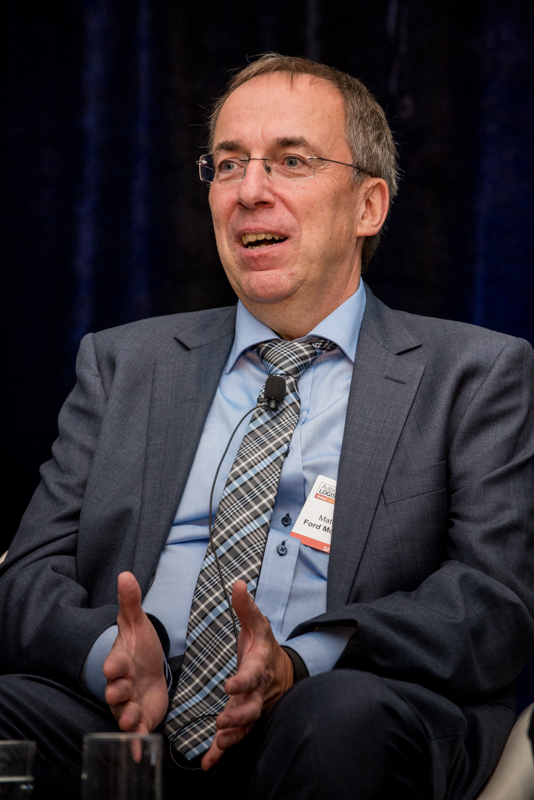Manufacturers and logistics providers at the Automotive Logistics Global conference are doing more to integrate their supply chains from end to end, and are keen to use data and analytics to anticipate problems before they arise.
As ever at Automotive Logistics Global conferences, the sheer size and increasing complexity of the automotive supply chain was on full display in the discourse and discussion of executives across manufacturers and logistics providers, many of which described the tremendous volume of cargo, part numbers and shipping flows that they are managing.
Take General Motors as an example. The carmaker now builds vehicles, powertrain, stampings and other components across 170 plants in 31 countries. It has a supply chain that includes more than 3,000 direct material suppliers providing parts from 6,300 locations. On any given day, around 200,000 unique parts flow into GM plants, and 30,000 new vehicles leave the factories.
Jim Bovenzi, executive director of the carmaker’s global purchasing and supply chain organisation in North America and for demand/supply globally, pointed out that it all adds up to an intense, expensive logistical undertaking. Around 900 logistics service providers around the world handle material and vehicles for GM between inbound and outbound flows; every day around 8,000 trucks carry parts to plants, at the same time that there are about 2,300 ocean containers landing on shore with GM material somewhere in the world. Outbound, the vehicles move to 20,000 dealers, of which around 5,000 are in the US.
Fiat Chrysler, which expects to build 5.3m vehicles by 2017 globally, including 2.5m in North America, is putting out 15,000 vehicles per day across an increasingly global supply chain. Steven Beahm, senior vice-president for supply chain management at FCA North America, revealed that international parts shipments for North America had more than trebled over the past two years, including both material coming to FCA’s plants in the region and for parts going abroad, such as for global Jeep production. It has meant not only substantial logistics volume but also coming to grips with managing an organisation and footprint stretched over more than 20 time zones and around 22 languages.
With the US heading close to another year of record sales, at around 17.5m units, and with North American production also heading towards all time highs, the momentum continues to push up logistics volume. Ryder, for example, a major logistics provider in North America, is handling some 11,000 border crossings between the US and Mexico every day, according to its chief executive officer, Robert Sanchez, with its business in the country growing 20% per year. The story would be the same at many logistics providers and carmakers, with the Mexican industry set to reach 5m units of light vehicle production by the end of the decade.
Not all the complexity and volume are necessarily about growth and expanding manufacturing and business opportunities. The industry has been rocked with a huge number of recalls, including safety campaigns, product replacements, environmental issues and systems updates. Anu Goel, currently vice-president of parts and vehicle logistics at the Volkswagen Group of America – and set to takeover as executive vice-president of group aftersales and service at the OEM next month – pointed out that in some cases carmakers like Volkswagen had to face recalls of more vehicles than it may sell in the US in a year. Meanwhile, an OEM may have just five days to notify customers of a recall, which is likely to be weeks if not months before it may have parts or a fix for the issues available. It is a difficult balance to strike between correcting a problem, being realistic about the supply chain, controlling costs and protecting a brand’s reputation.
With such complexity increasingly ubiquitous, automotive supply chain managers need a broader focus than kicking boxes, moving containers and ushering trucks through delivery gates. While execution of flows across the automotive sector is highly effective, the conference revealed how companies are also looking to be more strategic across the supply chain, including a better use of data and information sharing across large organisations and the supply base to better plan and design efficient networks and make better sourcing decisions. They also hope to use data and analytics to better predict and anticipate what they may face in the near-to-medium term.

Hanjin collapse: an industry prepared, or lucky?
It is not that the industry has displayed a huge gap in its performance or network optimisation; rather, there are examples where sourcing or production decisions don’t always take full account of expensive freight and logistics considerations. Likewise, the supply chain is often still at risk from sudden supplier capacity issues or weather events. During such times it still all too often that manufacturers are uncertain about where material is at a given time, or whether a lower tier supplier may be unable to deliver critical parts to a direct supplier to a carmaker.
An example of a recent ‘near miss’ has been the bankruptcy of South Korean container shipping line, Hanjin. The shipping line’s insolvency has led to many of its ships stranded at sea until ports could be assured they would be paid for port and handling fees; automotive manufacturers have braced themselves for possible material shortages or critical components that could have slowed or shutdown plants or deliveries of service parts.
As it turns out, there appear to have been few disruptions so far. However, that was not necessarily because manufacturers and logistics providers were well prepared. Executives from Toyota, Ford and Honda noted a lack of visibility and foresight in the situation, and suggested that the lack of disruption might have been as much about luck as being well prepared. Dana McBrien, associate chief advisor for logistics at Honda North America, said that the carmaker was “fortunate” not to have disruptions from the shipping line’s collapse.
“But did we have good detection methods or full visibility of what we have at sea when and where? Probably not. It is unfortunate that we are more reactionary in these situations,” he said.
Likewise, changes in demand in the market are not always reflected or anticipated well by the supply chain, whether that might mean imbalances in trucking and shipping dispatches, or over production of material or finished vehicles. Although the supply chain touches so many parts of a carmaker’s organisation, and should be in a position to understand what is happening in the market, it is often still reactive. During the strong growth of the past half decade or more, that has consistently led to supplier capacity issues and production instability; now, with the US market levelling off and susceptible to a potential slowdown or swing in demand, supply chain stakeholders need to be flexible and ready to make adjustments.
Carmakers and logistics providers do have tools at their disposal to get on top of such situations. Aleks Kobylecki, North American materials, international operations and customer service manager at Ford said that the carmaker was making a more concerted effort to understand its lower tier suppliers as a means to understand potential issues that might not be evident in direct material suppliers. Greg Slawson, regional vertical lead for automotive in the Americas for DSV, pointed to control tower systems and approaches to tracking freight and monitoring for potential disruption.
 Mike Schober said Toyota was starting to use data more strategically for service parts distribution
Mike Schober said Toyota was starting to use data more strategically for service parts distributionMike Schober, general manager for service parts and accessories operations at Toyota Motor Sales, said that Toyota has also looked carefully at its supply chain following several crisis, including the Japanese earthquake in 2011, about where it can strategically dual source components rather than relying on single sources.
But such approaches, however effective and necessary, have their limits. The lower tier supply chain often remains shared and less understand, said Matthias Schulz, director of North America material planning and logistics at Ford. He lamented that the automotive supply chain was not yet adept at predicting and anticipating potential issues. “The challenge is to forecast an event. It was actually quite predictable that one of the container lines would have troubles because of all the over capacity in the industry,” he said.
Schulz added that the industry needed to work together more to improve forecasting, including with logistics providers to understand more about transport flows and potential issues.[sta_anchor id=”3”]
Systems to predict and prepare
Such predictions are, of course, impossible to make concretely, however manufacturers are starting to turn such applications towards logistics. Mike Schober admitted that manufacturers have not always been able to fully understand what has been happening in the supply chain – data has always been plentiful but it was often buried in spreadsheets and difficult to interpret. But now, thanks to predictive analytical tools, such as Tableau, data can be better interpreted and become a predictor of what may happen.
“With such tools you can drop the data in and get a heatmap showing you where you need to focus,” he said. “We have been using it to try and reduce damage, for example, to see where fragile parts are most at risk in our network.”
Updating technology and systems are thus going to be important to helping manufacturers increase supply chain efficiency, particularly as many OEMs tend to rely on older, legacy systems. At GM, for example, Jim Bovenzi admitted that its logistics operations often relied on manual processes, including using excel spreadsheets to track parts and orders. At Ford, Aleks Kobylecki also said that many of its systems for monitoring and tracking parts were “long in the tooth” and would need to be updated over time. Honda’s McBrien also said that the carmaker did not necessary have the most up-to-date systems and processes – something that younger recruits accustomed to smartphone technology might be surprised about when they joined the carmaker.
At FCA, Steve Beahm pointed to a mishmash of systems across the company, especially globally where both Fiat and Chrysler had separate systems. “In many markets we have very different ways of ordering vehicles and parts which vary in their effectiveness,” he said. “If we were starting from scratch today we would do it another way, but we have to worked with what we have and update sensibly where we can.”
Bovenzi pointed to a business transformation process that will take several years to “bring GM’s systems into the 21st century”. For example, a new inbound logistics system is coming onstream next year, followed by a new outbound system in 2018. Other manufacturers have similar focus on improving IT and using new technology[sta_anchor id=”4”]
 Jim Bovenzi is at the head of an important realignment at GM’s wider supply chain and logistics organisation
Jim Bovenzi is at the head of an important realignment at GM’s wider supply chain and logistics organisationIntegrating supply chain organisations
However, as such systems are expensive and complicated to update, carmakers are also been looking more carefully at their internal organisations, communication and capabilities, with attempts to build a more cohesive, end-to-end organisation to cover operations from sourcing through to vehicle delivery.
Jim Bovenzi’s role at GM, for example, was created about 18 months ago in an effort to better integrate its various departments and “handover” points across the company’s wider logistics and supply chain functions. Bovenzi now has five departments that report to him, which include the carmaker’s very large global logistics and containers organisation; its supply chain group; and order fulfilment (“our window into sales,” as Bovenzi put it). On top of that, a new supply planning team was created to look at capacity issues across suppliers and anticipate them in advance. Finally, a demand planning team is also new, intended to look at long-term horizons, including model option penetration.
Bovenzi himself reports both to Steve Kiefer, vice-president of global purchasing and supply chain, who is ultimately responsible for GM’s purchasing around the world, as well to Alan Batey, president of GM North America, who is effectively responsible for total sales across the region.
“This is an integrated vision to unify the silos across GM, and make sure we have the right sourcing, right freight and packaging, as well as the strongest voice for the customer,” he said. “At the same time we need to optimise the whole process. I’m very excited at what the team has done and am proud in particular at what has been happening in logistics.”
As part of this organisational change, GM is also trying to strengthen capabilities in each department. In some cases that is supported by new software and systems, but Bovenzi indicated that the carmaker also wanted to rebuild skills and functions that had been outsourced over an extended period of time. He pointed in particular to the ability to engineer the logistics network as well as logistics sourcing capabilities, much of which has been lead by the carmaker’s lead logistics providers in recent years.
“We are slowly growing are in-house expertise for what had been outsourced. This will give us the ability to contrast and compare and be more consistent in our total supply chain, and help improve our visibility,” he said. “It is a big undertaking.”
 FCA’s Steve Beahm has reorganised the supply chain management function so that all S&OP functions are managed within it
FCA’s Steve Beahm has reorganised the supply chain management function so that all S&OP functions are managed within itThere are parallels at FCA, where Steve Beahm has led an organisational shift over the past two years and helped to build a supply chain organisation that has teams ready to respond and give input across all areas of the company, from marketing, suppliers and production to dealers and end customers. FCA’s NAFTA supply chain management thus now has seven sub-divisions, which bear some resemblance to GM’s new structure: commercial operations; demand and production planning; inter-regional flow and convergence; component capacity and production scheduling; inbound transport; supplier delivery and risk management; and a combined outbound logistics, Mexico and service parts purchasing.
According to Beahm, this structure has kept all of the functional areas of the supply chain connected, while it also ensures that sales and operations planning (S&OP) are managed entirely by the SCM group. Beahm suggested that this structure has reinforced close communication and regular meetings across the organisation to improve demand and supply forecasts, to develop production plans and implementation.
“We have a lot of leeway in our organisation and a lot of influence in making decisions across the company,” said Beahm.
This internal realignment has been accompanied by a deeper focus on communication with tier suppliers and logistics providers, also with a view of better understand and anticipating changes and improvements in the supply chain. Beahm pointed to twice yearly carrier roundtables, the use of detailed carrier scorecards, bulletins and monthly newsletter communication intended to increase transparency between FCA and its providers. Bulletins, for example, include EDI communication regarding sudden changes in production (such as breakdowns or supplier issues) to allow carriers to react and redeploy assets.
With online scorecards, Beahm says that FCA moved from monthly reporting to daily feedback to know if the actions providers were taking were effective. “This includes drill-down visibility that allows tracking back to the shipment and driver that caused the issue. Real time data allows real time root-cause analysis and action,” he said.
Beahm emphasised the importance of this improved supply chain planning and communication in the context of a strong market. Although FCA is forecasting a stable or mildly declining sales market in the US over the next few years, he points out that this is still maintained at historically high levels. In the meantime, FCA continues to launch a number of important new vehicles that require significant capacity and service among suppliers, inbound and outbound providers.
Increasing customer service
The complexity in production and the inbound parts supply chain is also reflected in service parts logistics, as is the demand for data and full visibility. This focus has arguably become even more of an imperative in the context of the so-called ‘Amazon effect’, in which customers expect to receive their products immediately, choose from a wide selection of products online and track delivery online. The result for many carmakers has been to increase service levels substantially to ensure that dealers receive stock orders everyday, with shorter order lead times and frequent delivery service.
Mike Schober at Toyota described how the carmaker has set a target of 15 hour lead times between dealers’ daily order cut off times in the evening, and the parts arriving via overnight delivery before dealerships open. The carmaker has achieved this by increasing the opening hours and shifts at its parts warehouses, by staying open through most holidays and using guaranteed overnight delivery.
Toyota has also expanded same-day delivery services, which include drop-off points for parts shipments in which dealers can then pick up parts; they have also added ‘will call’ options for parts pickup at distribution centres.
“While we still care about costs, today we consider ourselves to be a customer service organisation, and not only focused on efficiency,” said Schober.
Other carmakers, including Ford, Volkswagen, Nissan and GM, have also increased service and parts availability. In some cases, parts distribution is broken down to even faster, more frequent services by dealers who operate multiple facilities. Ralph Shaheen, owner of Shaheen Chevrolet, a dealership in Michigan, runs its own warehouse from which it delivers to uts dealers in relatively remote locations in the northern part of the state.
Shaheen, whose dealerships sell around $1.5m worth of service parts each month, said that the warehouse receives parts deliveries every morning by around 5am, mostly from GM’s parts distribution centre in Chicago. The warehouse, which stores around $6m worth of inventory, delivers twice per day to its dealership locations using its own trucks.
Manufacturers are keen to encourage this level of engagement among local dealers and distributors. At Ford, for example, the carmaker is in the process of launching a new, ‘all makes’ brand – Omnicraft – that will be available to customers across all brands of cars, according to Helmut Nittmann, global director for parts supply and logistics. It is part of a drive to increase the availability of options to customers as well as to expand the carmaker’s business with independent distributors.
 L to R: Louis Yiakoumi, Automotive Logistics; Mike Schober, Toyota; Jorge Roig, Volkswagen
L to R: Louis Yiakoumi, Automotive Logistics; Mike Schober, Toyota; Jorge Roig, VolkswagenBut while service and delivery levels have increased, those working across the service parts supply chain are just as anxious and interested in using data and improved forecasting techniques to improve inventory availability and make better decisions in the supply chain. Shaheen says that he is already using a retail inventory management system from GM that has improved his ability to forecast and anticipate parts demand.
Randy Creel, general manager of operations at Nissan North America, pointed out that the carmaker had been crunching data to encourage dealers to pair parts orders and avoid having to make multiple orders for the same repair job. For example, statistics have shown that replacing a compressor also tends to require new air filters, and so it might be effective to ship such parts together.
At Ford, the company has recently appointed an executive responsible for ‘big data’, with considerable expectations that such analysis will improve service parts distribution.
At Toyota, Schober also emphasised a constant focus on inventory, sales and delivery data. Review of such information is one of the reasons that the carmaker has recently changed its parts return policy. It found that dealers tended to buy too many of the wrong parts, which then take up space on shelves, in part to avoid paying fees to return the part. And the same time, some parts – such as special orders – were returned to Toyota only to be dispatched again several weeks or months later.
The new system allows for an unlimited returns policy without fees, provided that the dealer holds the part for a specific time period; for a general order, that is typically nine months, while for a special part it is six weeks. The time periods were based on data analysis of the periods in which parts were most likely to be required again.
A supply chain approach for recalls
There are still many limits to what such data and forecasting can provide, however. Schober points out that some of Toyota’s biggest difficulties are in forecasting parts that are on back order at suppliers, perhaps as a result of a supplier problem or capacity issues. In such situations, there is no way to provide customers with an accurate estimated time of arrival.
“Once a part is in the supply chain we can track and trace it but during exceptional issues things tend to fall apart,” he said. “Are there predictive analytics that would help us inform the customer about when they might expect the replacement? We haven’t figured this out.”
Difficulties in seeing and predicting these situations are at the heart of many recall and safety campaigns, issues that have reached unprecedented levels, including the Takata airbag recall and Volkswagen’s diesel emission scandal.
 Volkswagen’s Anu Goel said that recalls and safety campaigs need to be managed with a full supply chain perspective
Volkswagen’s Anu Goel said that recalls and safety campaigs need to be managed with a full supply chain perspectiveVolkswagen’s Anu Goel said that some recalls were so complex as to risk spiralling out of control. Customers have to be notified quickly, however a carmaker might struggle to actually obtain a fix or the full inventory of parts for some time afterwards. At the same time, customers may not respond equally to all recalls, usually acting faster if it’s an immediate safety issue, such as around drivetrain or brakes, but longer for other things (such as updates or environmental issues).
On the other hand, if customers all responded at the same time and quickly, it might present a capacity issue that the supply chain couldn’t handle.
Schober agreed that this could be a major issue for Toyota as well. He also emphasised that it was important to try to keep these exceptional issues as separate as possible from the normal supply of parts to dealers.
“Sudden events can disrupt our core regular business. We are trying to figure how to manage that more effectively,” he said.
For Goel, there is no magic answer or system available or likely to solve the issue. However, like his peers in managing the production supply chain, he points to the benefit of an approach in which supply chain leaders take responsibility and ownership across the process, working closely with production, sourcing and distribution to find the right solution. For example, suddenly needing 20,000 units of a particular part number is likely to become a capacity issue for suppliers making the same part for assembly plants. Allocating capacity and service is a multiparty effort, requiring compromise and help from different stakeholders.
“Everyone is a business partner that you have to work with across the supply chain in these campaigns. If you can’t get your head around that, it won’t work,” said Goel.
For Volkswagen Group of America, these campaigns are the responsibility of the group aftersales and service function (which includes service parts and vehicle logistics) even though it’s not something officially in the job description. But this role is best placed to manage it, as it works across sales, engineering, logistics and communication, while reporting directly to the chief executive.
 Frederiek Toney, president of the Ford Customer Service Division, and previously head of global material planning and logistics for the carmaker, gave an inspirational speech on how to lead complex organisations and to get the most out of a supply chain organisation.
Frederiek Toney, president of the Ford Customer Service Division, and previously head of global material planning and logistics for the carmaker, gave an inspirational speech on how to lead complex organisations and to get the most out of a supply chain organisation.
The full video of the presentation can be viewed by clicking here
Click here for Automotive Logistics feature interview with Frederiek Toney from early in 2016
“We have 70-75% of the areas needed to accomplish it, and are best placed to manage it. The alternative is to create a ‘VP of campaigns’, which few brands seem to want to do,” he said.
Managing this task clearly requires close collaboration with suppliers and dealers, especially in determining how best to handle the volume and repairs. One example could be a targeted allocation, in which customers are requested to come to dealers by VIN number, in an effort to distribute available inventory as evenly as possible. Such approach, however, is bound to rile some dealers who don’t want to come last in the queue.
Other approaches are to place upper limits on dealer orders. For example, a dealer might be allowed to order only 10 units at a time, 5 of which would be dispatched immediately, the other 5 put on back order.
Otherwise an ‘open order’ system can be used that allows dealers to order as much as they need.
“The best option is often some kind of hybrid between all of these methods, in which you can get a handle on your inventory and then offer the dealers an automatic replenishment,” he said. “That way you are metring out your inventory, but also able to give the dealers what they need. Our benchmarking suggests this is what dealers most prefer.”[sta_anchor id=”8”]
More than a supply chain fad
Carmakers, tier suppliers and logistics providers face no shortage of challenges across North America. If growth continues even at a mild pace, the industry will still be operating at close to capacity, with pockets of very strong growth, such as Mexico, likely to outpace available transport assets or infrastructure investments.
In some areas these developments offer clear opportunities for companies that can offer alternatives. Carmakers including FCA, Ford and GM, for example, are already using more short-sea shipping export routes from Mexico to the US and Canada for flows that would have traditionally moved by rail; the Volkswagen Group, which is launching Audi production, is also exploring similar options.
However, not every challenge facing the sector has such an identifiable solution. Robert Sanchez, Ryder’s chief executive, pointed to an increasing shortage of truck drivers – he suggested that a current shortage of 50,000 across the trucking industry this year could grow to 150,000-300,000 by 2020 – as well as a lack of qualified diesel mechanics and other technicians, all of which are critical to companies like Ryder. The provider has taken measures to address this, including programmes to hire more women drivers and military veterans, but demographic issues, regulatory constraints and high employment levels are making it hard.
Some may hope that new technology developments may offer solutions to staff and skills shortages, including advanced automation, drones, artificial intelligence and driverless vehicles – much of which has potential applications in the logistics space. And following the rise of Uber and Tesla, interest in the ‘Google car’, it would appear that the tech industry is turning fully towards the transport and logistics sector as the next one to disrupt. On a recent trip to Silicon Valley, Sanchez said that he came across many venture capitalist investors with interest in the sector.
 Ryder CEO Robert Sanchez said that the logistics industry could be short up to 300,000 drivers by 2020
Ryder CEO Robert Sanchez said that the logistics industry could be short up to 300,000 drivers by 2020But technology may be as much a threat to some providers or vehicle manufacturers’ business models over the coming years, whether through online brokerage or various kinds of asset sharing. Sanchez suggested that Ryder would need to work hard to innovate and adapt new technology into its own processes.
Manufacturers also pointed to the limits of some of the latest technology fads, at least for now. While drones are touted as potential vehicles for last mile delivery, technical and regulatory barriers persist. The use of the technology in logistics so far is somewhat more mundane, notably in monitoring inventory in warehouses or across large container or vehicle yards. Jorge Roig, director of logistics planning for Volkswagen at its plant in Chattanooga, Tennessee, said his company had started to use the technology for these purposes.
“I don’t think we are necessarily using something that others are not, but are focus right is to work intensively on in-house logistics processes, including a wider use of AGVs [automatic guided vehicles] in the plant and drones in the warehouses,” he said.
Mike Schober said that he didn’t see an immediate use for drone technology in moving parts between parts centres or dealers. He also cautioned that carmakers should be careful about rushing prematurely into technology and automation – he cited examples where investment in warehouse equipment had proved to be more costly and less useful than existing processes.
In future, however, he envisaged scenarios in which Toyota and other carmakers would get more involved in shipping parts directly to customers through ecommerce solutions. In those circumstances, the potential for something like a drone or an Uber solution with private drivers could be more interesting. “I want to send the message to all of our logistics providers that we will consider all new ideas to get parts to our customers,” he said.
Ford’s Matthias Schulz also emphasised that logistics providers and OEMs should be open to new technology, but likewise he reminded delegates that there were still plenty of opportunities for leaner processes and improvements in today’s supply chain.
“There are no secrets out there regarding technology, and as more gets adapted in the sector, we will start to use it,” he said. “But what we should not forget is that huge opportunities exist in traditional methods of doing things. We will have a long way to go.”
Automotive Logistics Global is part of the global Automotive Logistics series of conferences.
The next conference in the series is the inaugural Automotive Logistics UKin London on October 5-6th.
The next conference in North America will be the 2017 Automotive Logistics Mexico conference January 31st - February 2nd in Mexico City.

























![Global[1]](https://d3n5uof8vony13.cloudfront.net/Pictures/web/a/d/s/global1_726550.svgz)














